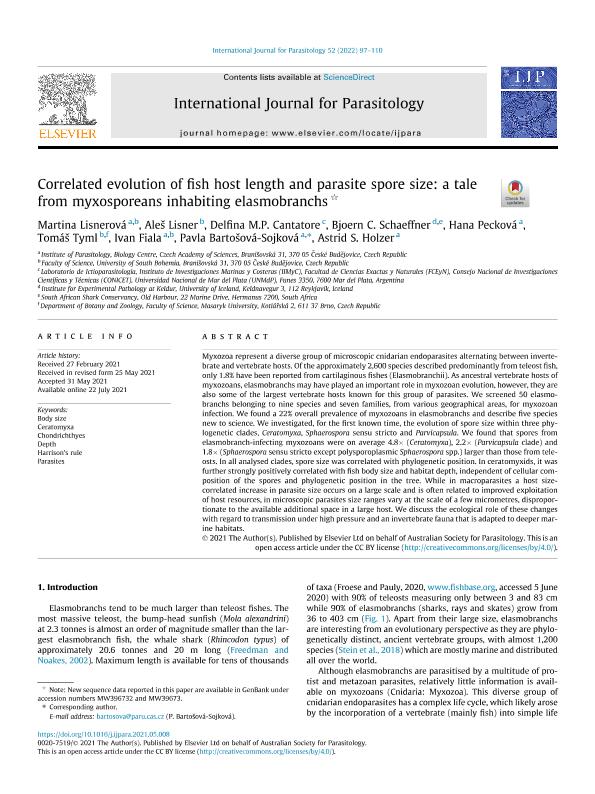Mostrar el registro sencillo del ítem
dc.contributor.author
Lisnerová, Martina

dc.contributor.author
Lisner, Ales
dc.contributor.author
Cantatore, Delfina María Paula

dc.contributor.author
Schaeffner, Bjoern C.
dc.contributor.author
Pecková, Hana
dc.contributor.author
Tyml, Tomáš
dc.contributor.author
Fiala, Ivan
dc.contributor.author
Bartošová Sojková, Pavla
dc.contributor.author
Holzer, Astrid Sybylle

dc.date.available
2022-06-03T15:46:22Z
dc.date.issued
2022-02
dc.identifier.citation
Lisnerová, Martina; Lisner, Ales; Cantatore, Delfina María Paula; Schaeffner, Bjoern C.; Pecková, Hana; et al.; Correlated evolution of fish host length and parasite spore size: a tale from myxosporeans inhabiting elasmobranchs; Elsevier; International Journal for Parasitology; 52; 2-3; 2-2022; 97-110
dc.identifier.issn
0020-7519
dc.identifier.uri
http://hdl.handle.net/11336/158904
dc.description.abstract
Myxozoa represent a diverse group of microscopic cnidarian endoparasites alternating between invertebrate and vertebrate hosts. Of the approximately 2,600 species described predominantly from teleost fish, only 1.8% have been reported from cartilaginous fishes (Elasmobranchii). As ancestral vertebrate hosts of myxozoans, elasmobranchs may have played an important role in myxozoan evolution, however, they are also some of the largest vertebrate hosts known for this group of parasites. We screened 50 elasmobranchs belonging to nine species and seven families, from various geographical areas, for myxozoan infection. We found a 22% overall prevalence of myxozoans in elasmobranchs and describe five species new to science. We investigated, for the first known time, the evolution of spore size within three phylogenetic clades, Ceratomyxa, Sphaerospora sensu stricto and Parvicapsula. We found that spores from elasmobranch-infecting myxozoans were on average 4.8× (Ceratomyxa), 2.2× (Parvicapsula clade) and 1.8× (Sphaerospora sensu stricto except polysporoplasmic Sphaerospora spp.) larger than those from teleosts. In all analysed clades, spore size was correlated with phylogenetic position. In ceratomyxids, it was further strongly positively correlated with fish body size and habitat depth, independent of cellular composition of the spores and phylogenetic position in the tree. While in macroparasites a host size-correlated increase in parasite size occurs on a large scale and is often related to improved exploitation of host resources, in microscopic parasites size ranges vary at the scale of a few micrometres, disproportionate to the available additional space in a large host. We discuss the ecological role of these changes with regard to transmission under high pressure and an invertebrate fauna that is adapted to deeper marine habitats.
dc.format
application/pdf
dc.language.iso
eng
dc.publisher
Elsevier

dc.rights
info:eu-repo/semantics/openAccess
dc.rights.uri
https://creativecommons.org/licenses/by/2.5/ar/
dc.subject
BODY SIZE
dc.subject
CERATOMYXA
dc.subject
CHONDRICHTHYES
dc.subject
DEPTH
dc.subject
HARRISON'S RULE
dc.subject
PARASITES
dc.subject.classification
Otros Tópicos Biológicos

dc.subject.classification
Ciencias Biológicas

dc.subject.classification
CIENCIAS NATURALES Y EXACTAS

dc.title
Correlated evolution of fish host length and parasite spore size: a tale from myxosporeans inhabiting elasmobranchs
dc.type
info:eu-repo/semantics/article
dc.type
info:ar-repo/semantics/artículo
dc.type
info:eu-repo/semantics/publishedVersion
dc.date.updated
2022-05-06T16:23:50Z
dc.journal.volume
52
dc.journal.number
2-3
dc.journal.pagination
97-110
dc.journal.pais
Países Bajos

dc.journal.ciudad
Amsterdam
dc.description.fil
Fil: Lisnerová, Martina. Academy of Sciences of the Czech Republic. Biology Centre. Institute of Parasitology; República Checa. University of South Bohemia; República Checa
dc.description.fil
Fil: Lisner, Ales. University of South Bohemia; República Checa
dc.description.fil
Fil: Cantatore, Delfina María Paula. Consejo Nacional de Investigaciones Científicas y Técnicas. Centro Científico Tecnológico Conicet - Mar del Plata. Instituto de Investigaciones Marinas y Costeras. Universidad Nacional de Mar del Plata. Facultad de Ciencias Exactas y Naturales. Instituto de Investigaciones Marinas y Costeras; Argentina
dc.description.fil
Fil: Schaeffner, Bjoern C.. University of Iceland; Islandia
dc.description.fil
Fil: Pecková, Hana. Academy of Sciences of the Czech Republic. Biology Centre. Institute of Parasitology; República Checa
dc.description.fil
Fil: Tyml, Tomáš. University of South Bohemia; República Checa. Masaryk University; República Checa
dc.description.fil
Fil: Fiala, Ivan. Academy of Sciences of the Czech Republic. Biology Centre. Institute of Parasitology; República Checa. University of South Bohemia; República Checa
dc.description.fil
Fil: Bartošová Sojková, Pavla. Academy of Sciences of the Czech Republic. Biology Centre. Institute of Parasitology; República Checa
dc.description.fil
Fil: Holzer, Astrid Sybylle. Academy of Sciences of the Czech Republic. Biology Centre. Institute of Parasitology; República Checa
dc.journal.title
International Journal for Parasitology

dc.relation.alternativeid
info:eu-repo/semantics/altIdentifier/url/https://www.sciencedirect.com/science/article/pii/S0020751921002186?via%3Dihub
dc.relation.alternativeid
info:eu-repo/semantics/altIdentifier/doi/http://dx.doi.org/10.1016/j.ijpara.2021.05.008
Archivos asociados
